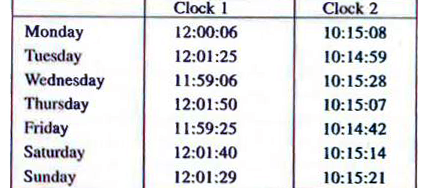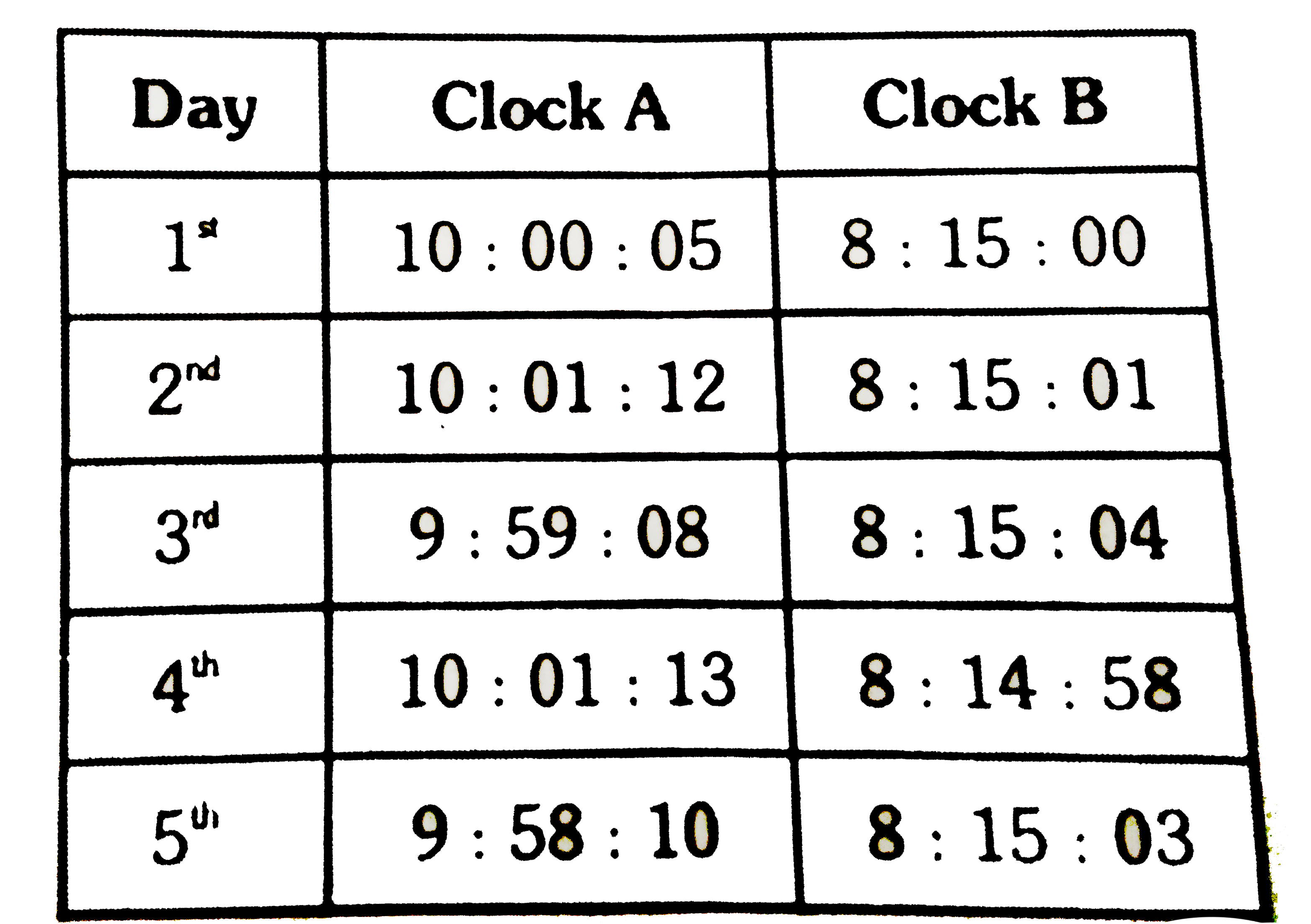Two clocks are being tested against a standard clock located in a national laboratory. At 12:00:00 noon by the standard clock, the readings of the two clocks are :
Clock 1Clock 2Monday12:00:0510:15:06Tuesday12:01:1510:14:59Wednesday11:59:0810:15:18Thursday12:01:5010:15:07Friday11:59:1510:14:53Saturday12:01:3010:15:24Sunday12:01:1910:15:11
If you are doing an experiment that requires precision time interval measurements, which of the two clocks will you prefer ?
The range of variation over the seven days of observation is 162 s for clock 1, and 31 s for clock 2. the average reading of clock 1 is much closer to the standard time than the average reading of clock 2. The important point is that a clock's zero error is not as significant for precision work as its variation, because a 'zero-error' can always be easily corrected. Hence closk 2 is to be preferred to clock 1.
Topper's Solved these Questions
Similar Questions
Two clocks are being tested against a standard clock located in a national laboratory At 12 : 00 : 00 noon by standard clock, the readins of the two clocks are
DayClock - IClock - IIMonday12:00:0510:15:06Tuesday12:01:1510:14:59Wednesday11:59:0810:15:18Thursday12:01:5010:15:07Thursday12:01:5010:15:07Friday11:59:1510:14:53Saturday12:01:3010:15:24Sunday12:01:1910:15:11
From the Observations carefully read the following conclusive statements.
Statement I : Zero - error in clock II is much longer than zero - error in clock I.
Statement II : Zero - error can always be corrected by applying necessary corrective measures
Statement III : Precision of clock - I is more than precision of clock - II
Statement IV : Precision of clock - II is more than precision of clock - I
Pick up the correction option from the following.
View SolutionTwo clocks A and B being tested against a standard clock located in the national laboratory At 10.00 AM by the standard clock, the readings of the two clocks are shown in following table
DayClock AClock BIst10:00:068:15:00IInd10:01:138:15:0.1IIIrd9:59:0.88:15:04IVth10:02:158:14:58Vth9:58:108:15:02
If you are doing an experiment that requires precision time interval measurements, which of the two clocks will you prefer ?
View Solution
Knowledge Check
Two clocks A and B being tested against a standard clock located in the national laboratory At 10.00 AM by the standard clock, the readings of the two clocks are shown in following table
DayClock AClock BIst10:00:068:15:00IInd10:01:138:15:0.1IIIrd9:59:0.88:15:04IVth10:02:158:14:58Vth9:58:108:15:02
If you are doing an experiment that requires precision time interval measurements, which of the two clocks will you prefer ?Aclock ABclock BCeither clock A or clock BDNeither clock A nor clock BIf in a clock ,12 is replaced by 1,11 by 2, 10 by 3 and so on , then what will be the time in that clock corresponding to twenty minutes past three in the usual clock ?
ATwenty minutes past elevenBForty minutes past tenCForty minutes past 1elevenDNone of the aboveA clock gains 15 minutes per day. It is set right at 12 noon. What time will it show at 4.00 am, the next day?
A4:10AMB4:45AMC4:20AMD5:00AM
Two clocks are being tested againest a standard clock located in a national laboratory.
At 12 : 00 : 00 noon by the standard clock, the readings of the two clocks are

Which of the two clocks will you prefer to measure the time intervals during an experiment?
View SolutionTwo clocks are being tested against a standard clock located in a national laboratory .At 12:00:00 noon by the standard clock, the readings of the two clocks are
Day 1Day 2Day 3Day 4Day 5Clock 112:00:0412:02:1912:01:5011:59:0411:59:08Clock 211:15:2411:15:0111:14:5911:15:0011:14:58
Which of the two clocks will you prefer to measure the time intervals during an experiment ?
View SolutionTwo clocks are being tested against a standard clock located in a national laboratory. At 12:00:00 noon by the standard clock, the readings of the two clocks are :

If you are doing an experiment that requires 'precision time interval' measurements , which of the two clocks will you prefer ?
View SolutionTwo clocks are being tsted against a standard clock located in the national laboratory. At 10:00:00 AM by the standard clock, the readings of the clocks are :

If you are doing an experiment that requires prescision time interval measurements, which of the two clock will you prefer ?
(a) Clock A
(b) Clock B
(c) Either Clock A or B
(d) Neithr A nor B
View SolutionTwo clocks are being tsted against a standard clock located in the national laboratory. At 10:00:00 AM by the standard clock, the readings of the clocks are :

If you are doing an experiment that requires prescision time interval measurements, which of the two clock will you prefer ?
(a) Clock A
(b) Clock B
(c) Either Clock A or B
(d) Neithr A nor B
View Solution
